Last Updated on March 21, 2024 by Maged kamel
Solved problem 4-13 to estimate stiffness reduction τb.
The content of the pdf I used in the illustration.
We will discuss solved problem 4-13 from Prof.Segui’s book.

In the next slide image, there is two equations as indicated in the AISC clause 16.1.27. There are two conditions. αPr/Pns <=0.50 and αPr/Pns>0.50. Pr is the required axial compressive strength either obtained by using LRFD or ASD. α =1 (LRFD) or α =1.6 (ASD). The Pns is the cross-sectional compressive strength=Ag*Fy for non-slender elements.
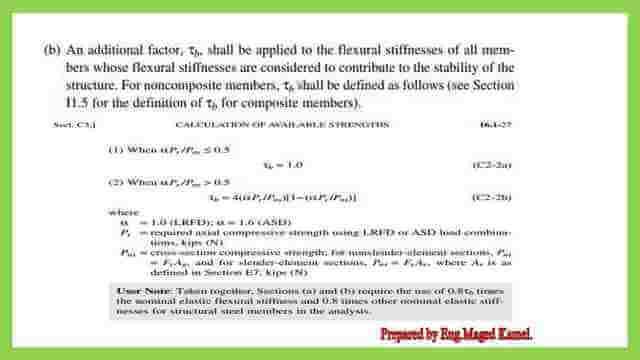
Let us review first, a test will be done to check that, αPr/Pns <=0.50. there is no reduction, the same points will coincide with each other. Then τb=1, but αPr/Pns>0.50, then the equation can be used.
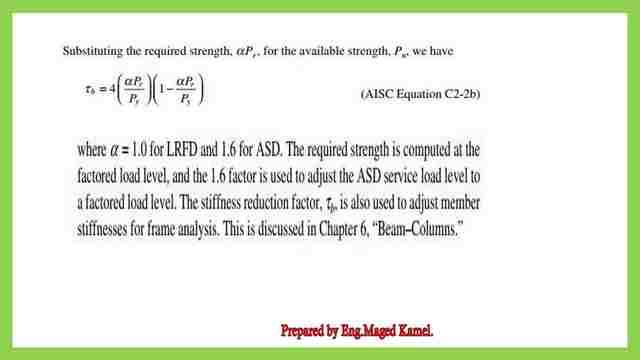
Two values for α, For LRFD=1, while for the ASD α=1.60.
Our solved problem 4-13, A w10 x54 of ASTMA992 is subjected to a service load of 100 kips and a service Live load of 200 kips. If the slenderness ratio makes this member, an inelastic column, what is the stiffness reduction, τb? This means that kl/r is <4.71*sqrt(E/fy) for that column which =113 for Fy= 50 ksi.
The stiffness reduction τb to be estimated. For section W10x64, in our solved problem 4-13. We can get the gross area Ag, which is 15.80 inch2 after reviewing the data from the W section tables.
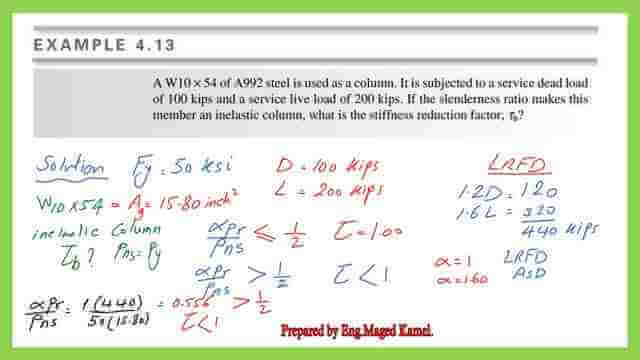
What is the information that we have? We cannot estimate τb in LRFD, without the evaluation of Pult, the ultimate column load.
Check the value of α based on the data given.
If we start with the LRFD calculations, the value of Pult=1.2D+1.60L, should be >1.4D. We have Dl=100 kips and LL=200 kips. Pult=1.20100+1.60200, we have 1.2D=1.20100,1.6 L=1.60200, Pult=440 kips, α =1, for the LRFD, while α =1.6, for the ASD.
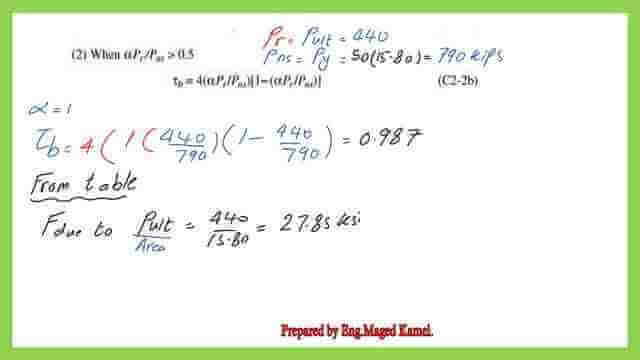
First check that *αPr/Pns <=0.50, we have α=1, Pr=Pult=440 kips, Ag=15.80 inch2, Pns=Fy*Ag. Fy=50.0 ksi while Ag=15.80 inch2. Pns=50*15.80, then αPr/Pns=0.566, check this value with if >0.50 then τb<1, which in our case, since we have 0.556 >0.50, then τb <1.0.
How to use Table 4-13 for LRFD design?
The equation will be τb= 4(α*Pr/Pns)*(1-(α*Pr/Pns)).This term (αPr/Pns) exists outside and inside the bracket. Recall Pr=Pult=440 kips.Pns=Py=5015.80=790 kips with α=1, then τb=4((1440/790)*(1-(440/790))=0.987, if we wish to use the table, then we will need Fult=Pult/AG. Fult=440/15.80.We need the value of the stress which is 440/15.80=27.85 ksi.
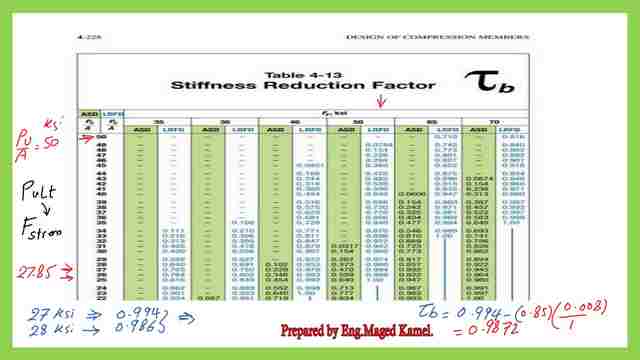
The table is Table 4-13, the title is Stiffness Reduction Factor. We have Fult=27.85 ksi, this figure is between 27 and 28 ksi, we use the table, we move horizontally from left to right at 27.0 ksi, we get τb=0.994, while at Fcr=28.0 ksi, we have τb=0.986.
We make interpolation, then τb=0.9872, which is close to that figure obtained from the general equation.
How to estimate τb for ASD Design.
Let us proceed with the ASD, in our solved problem, 4-13. We will evaluate Pt=PD+PL=100+200=300 kips. Py=Fy*Ag=50*15.80=790 kips.
Perform the first check, which we normally start with, considering α=1.60, αPr/Pns>0.50 or not, then we have α=1.60, Pt=330 kips. Perform the first check, which we normally start with, considering α=1.60, αPr/Pns>0.50 or not, then we have α=1.60, Pt=330 kips.
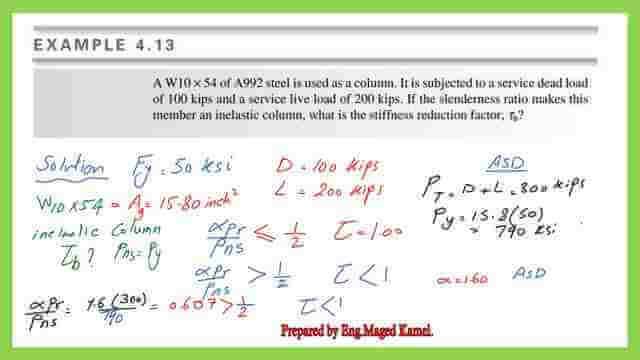
Pns=790, then αPr/Pns=1.60*300/790=0.607>0.50, then τb will be < 1.0, and we perform our estimation from the equation. τb= 4(α*Pr/Pns)*(1-(αPr/Pns)), Pr=Pt=300 kips, Pns=790 kips, α=1.60. We apply this equation, then τb=0.9536.To use the table again we need to have the value Ft=Pt/Ag, Pt / Ag, the Pt= 300 kips/15.80 ft= 18.989 ksi. We have Pe/A=18.98 KSI.

For Fy = 50 ksi. we draw a vertical line from fy=50 ksi at the ASD section between 18 ksi,19 ksi from the left side. We draw another line, at the intersection. We have τb will be between 0.953 and 0.977, and can be estimated as 0.953.
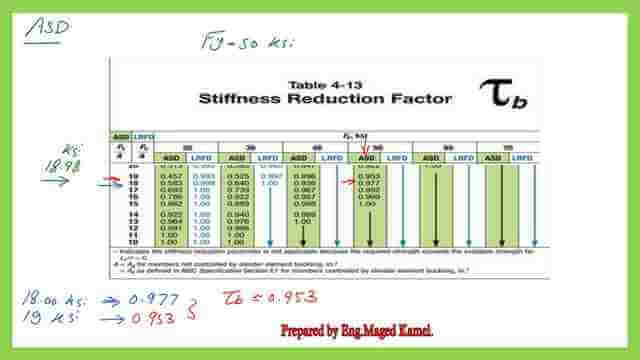
This is a link for the pdf file used in the illustration of this post.
This is the link to the previous post, Stress reduction factor for inelastic columns.
This is the next post is the solved problem, 4-14.
This is a link to a useful resource-A Beginner’s Guide to the Steel Construction Manual, 15th ed.

